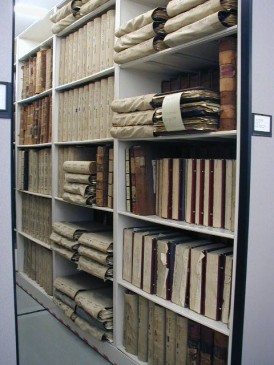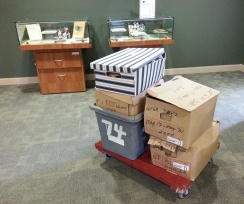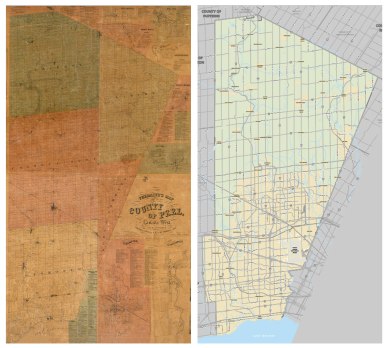You may have seen archivists on television helping people to discover their roots in old records or talking to historians (or detectives!). But you might be wondering what archivists do the rest of the day. Even if you visit an archive – and we hope you will – a lot of what we do goes on behind the scenes.
In this post, we’ll give you a sneak peek into the daily tasks of the archivist. It’s important for you to know what we do because the materials we preserve for the future belong to everyone. These records don’t just tell us where we came from; they also contain evidence used to make current decisions that will affect our lives now and in the future. (For more on the value of archives, see our post “Why Archives Matter”.)
Knowing how archivists work can also help you as a researcher to use archives. Archivists use terminology and techniques that are unique to their profession. An understanding of how archives are structured will help you interpret and appreciate archival records.
To put our work in context, remember that at PAMA’s archives we take care of government and private records documenting places and people in the geographical area of what is now the Region of Peel. To get a sense of the scope of subject matter we deal with, jump to the end of this article.
Here’s a closer look at our core tasks.
Obtaining and assessing records
Appraisal, selection, and acquisition
Aside from government records, much of the archival material we acquire comes in as donations. We document every stage of the donation process so that donors and archivists know what, when, and how material is being given.
Archivists need to be selective about what material we accept in the interests of building a representative and cohesive collection. To do this, we team acquisition of records with appraisal.
If you’ve watched antique shows, you might associate “appraising” a collection with determining how much money it’s worth. Archivists do need to do this for insurance or tax purposes.
But archival appraisal is a much broader and more important task. Archives can’t and don’t keep everything from the past. Appraisal means making methodical judgements about what should be kept for the future (and why, and how) – all the while trying to make sure we aren’t favouring our own biases.
Because our appraisals decide what makes it into the archives, we determine which voices from the past will be heard in the future. That’s quite a responsibility!
Appraisal involves all these things:
- Visiting potential donors of large collections to see if and how much material should be saved
- Studying individual documents as we organize them (see below)
- Researching the background history and context of collections
- Writing reports documenting our reasons for accepting or declining records
- Reviewing documents to ensure privacy legislation is observed and copyright status is clear
Organizing and storing records
Arrangement
Accepting documents into the archives is only the beginning. Records are meant to be consulted, but they seldom arrive in a condition that is easy to use or interpret. Archivists organize and document the content of groups of records; by doing so they both preserve documents and make them useable.
One step is to arrange the material in a way that doesn’t disturb important connections, clarifies how the records were used, related, or collected, and makes it easier to navigate the records. Archival arrangements are usually hierarchical and involve divisions and subdivisions of topics.
As we carefully work out a way to structure a collection, we physically process the records based on this organization by sorting, filing, labelling and rehousing records in archival containers.
Arrangement isn’t just filing. In fact it’s so tricky that we’ll write another post on how archival records are organized.
Description
How do you know which archival collections to use? Archivists have developed systematic ways to summarize collections – called descriptions—that give researchers snapshots of what they can expect to find in collections. Archivists need to choose their words carefully, thinking about the best way to capture important points about a collection; descriptions are a window on the content of the collection.
Descriptions form part of finding aids, or guides to individual archival collections. (You can consult finding aids in our reading room.) We also enter descriptions into our onsite database.
Of course we don’t and can’t often list every individual item in a collection. The description can tell you whether a collection is a good bet for your research, but there’s always work for researchers to do in discovering archival material relevant to their own projects.
For more, see our post on how archivists describe collections (it will give you some tips on deciphering finding aids too).
Preservation and conservation
Older records can be vulnerable in many ways, from 1880s brittle paper to 1980s unreadable floppy disks. We stabilize records by housing them in protective containers and storing them in climate controlled conditions. We also need to know how to deal with some conservation problems, like tears in paper or obsolete digital formats.

Our senior archivist is assessing very mouldy documents outside to make sure people and other records inside are not exposed.
For complex or badly damaged records we sometimes need to call on expert conservators. We also selectively digitize records so that they can be viewed without handling the originals more than necessary.
Connecting people with records
Reference
Once we’ve made records useable, we can help people to consult them.
One of our essential functions at PAMA’s archives includes answering inquiries from four municipal governments. We’re frequently called upon to provide documents to governmental bodies as they make decisions about planning, legal, and other matters.
 A large part of our day also includes helping citizens to use the records we’ve processed. Because we work so closely with collections, we’re a good resource when you’re wondering what directions to follow in your research.
A large part of our day also includes helping citizens to use the records we’ve processed. Because we work so closely with collections, we’re a good resource when you’re wondering what directions to follow in your research.
We help people in all kinds of ways, from deciding what records to access, to deciphering old handwriting, interpreting unfamiliar record types, and using our microfilm readers.
Collaboration and outreach
Here at PAMA, we work closely with both the museum and the art gallery to help plan exhibitions on a variety of themes. We also plan our own exhibits shown in our reading room so that you can see fascinating groups of records up close. As time allows, we also sometimes provide presentations for community groups.
Administration
Like any other job, the archivist’s working day also includes lots of administrative tasks, like keeping statistics on archives use, registering archival researchers, ordering special supplies, supervising student interns, keeping our space safe and secure, maintaining our technological tools, and making sure the phones and emails are answered.
Bringing the past, the present, and the future together
Over time, Peel has comprised all of these:
- A geographical area twice the size of post-amalgamation Toronto
- Seventeen municipalities
- Over 130 named communities as well as hundreds of old and new subdivisions
- About 140 cemeteries
- Hundreds of schools and churches
- Thousands of organizations and associations
- Tens of thousands of businesses
- Millions of residents
Every month we take in boxes of records from government and private donors, and we field numerous inquiries from people throughout the province and beyond.
The answers to these questions sometimes find their way into new records which then find their way to us. No wonder we have our hands full!
Taking care of archives can be a surprisingly busy occupation. We think it’s also one of the best in the world.
posted by Samantha Thompson, archivist








Pingback: This week’s crème de la crème — July 18, 2015 | Genealogy à la carte·
This a fulfilling occupation Thanks for this article. I am very impressed with the detail in this article. Thanks for sharing it!
LikeLike
Thanks for your comment! It’s always good to know that we’re spreading the word about the value of archives.
LikeLike
Pingback: Inquiring Minds Want to Know – What Do Archivists Do? | Ifill/DoubleBack Global Group·
Pingback: Hello world! | uogspecialcollections·
Reblogged this on ginnyandthemoon.
LikeLike
Thanks for spreading the word!
LikeLike
Reblogged this on A Day in a Life of a Military Archivist *Eddy Hamelin*.
LikeLike
Thanks for the support!
LikeLike
Reblogged this on violettempest and commented:
An interesting post about what goes on behind the scenes.
LikeLike
Thanks so much for reading and sharing!
LikeLiked by 1 person
Check @RAINbyte which tweeted your posting
LikeLike
Thanks for letting us know about your feed!
LikeLike
Great post. Thanks for the work you do.
LikeLike
Appreciation is always much appreciated. Thanks!
LikeLike
A very interesting article. I am now at the university studying to become an archivist and I really agree with all of this. Being an archivist is a nice and fulfilling job.I hope I will be a good one .
LikeLike
Thanks for taking the time to comment, Rebecca. All the very best in your studies – we’re sure you’ll be an asset to an important profession.
LikeLike
A beautifully written article which accurately summarizes what being an archivist is all about. I just completed my archival studies and I look forward to finally making my contribution to the archival world.
LikeLiked by 1 person
Thanks for your perspective! Welcome to the profession and all best wishes for your future.
LikeLike
A great article also from a records manager’s point of view on how we share the recordkeeping work. I’ve shared this on @NottsFinn
LikeLike
Great to have a comment from an RM professional. Of course we work closely with RM – maybe we’ll write a post on how that works!
LikeLike
Pingback: How do archivists organize collections? | Archives @ PAMA·
Pingback: Old and New World Archives share the past, present, and future: The Cumbrian Connection, Part 1 | Archives @ PAMA·
Pingback: The question all Archivists get is… – Arcavee·
Pingback: Seven Statements about Archives: Best of the Blog 2016 | Archives @ PAMA·
Pingback: Archives Management – Courses in the Philippines: College, TESDA, Online, Short Courses·
I had no idea that archivists had to make decisions of what parts of their collection to keep. When I think of an archive I think of massage storage where everything is kept and nothing is lost. It is interesting that as they go through the appraisal process, pieces are deemed as unworthy of being in the collection any longer. It could be a good idea to contact an archivist that you know and see if they have any pieces they are getting rid of that you could buy.
LikeLike
Hi Joy, We’re glad that you found the article interesting. Many people do assume that archives keep everything ever created. Besides being impossible, this wouldn’t even be advisable as some records don’t have enough informational or evidential value to merit long-term retention for 100s of years into the future (and keeping everything would make the really archival stuff harder to find and use). It’s true that the selection process is quite a responsibility as archivists are determining how people in the future will view the past and we so do this by evaluating collections based on a consensus of criteria (and not just on our own personal likes and dislikes). We should clarify that the appraisal process is done before we decide to take something into the archives. Once we do, we are committing to it and rarely get rid of things. Getting rid of things is called de-accessioning and when it does happen, we also have to adhere to strict guidelines. Sometimes, for example, we might transfer the material to another organization who might be a better fit for it. There would be ethical problems selling anything that had once been in our collections.
LikeLike
This is a great description of what archivists do. I am going to share it with our practicum students. Thank you!
LikeLike
Thanks very much Mary, your comments mean a lot. Keep fighting the good fight.
LikeLike
Pingback: Why don’t archivists digitize everything? | Archives @ PAMA·
Pingback: What makes for an archives? A look at the core archival functions – ActiveHistory.ca·
Pingback: Who and Where are the Librarians? – Dhruti Kari Bhagat·
Pingback: Module 7: Archives – Guthrie Museum (2/28) – Intro to Digital Humanities·
Pingback: To The Woody Guthrie Center We Go – Chelsea Buczek·
Pingback: Describing Archives in “Plain” Words | INFO 256: ARCHIVES&MANUSCRIPTS·
Pingback: What do archivists keep (or not)? | Archives @ PAMA·
Pingback: Archives Moment: Ask An Archivist Day – Oct 7, 2020 – Musée Héritage Museum·
So if those dearchived articles are unethical to sell to 4andom individuals, where do they go after being designated unworthy of keeping?
LikeLike
Hi Laura, thanks for asking. The first choice of ways to deal with deaccessioned material is to find a more appropriate institutional home for it. We’ll offer such material to other archives, libraries, or museums who feel it fits their collecting mandate. (That’s why it’s good for collecting institutions to maintain professional networks.) Failing a rigorous attempt to place the material in another permanent collection elsewhere, we’ll also offer it to educators like our own at PAMA or teachers – they can often use it for show-and-tell and study purposes.
LikeLike
Pingback: 2/2-2/4 Readings and assignments – Intro to Digital Humanities·
Pingback: Popular culture and the duties of archivists – Wading Through The Cultural Stacks·
Pingback: Describing Archives in Plain Works – Little Bird Press·
Pingback: Holding History: Revealing the Archivists Role – United Farmers Historical Society·